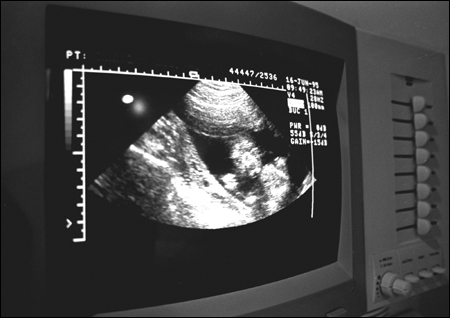Early experiences alter the baby’s brain
Preemies must be brought up to date

Preterm babies are born with preterm brains. They need to learn in the harsh world outside the womb what normal babies learn inside the comfort of their mothers’ bodies.
Differences in brain structure and function in preemies as young as 28 weeks show up when they are compared with full-term babies (40 weeks). MRI scans show significantly fewer connections in the early brains, which are reflected in the way these babies move, and how they explore themselves and the rest of the world.
For all babies, leaving the comfort of the womb is a traumatic separation from a rich, nurturing environment. Life is especially difficult for preemies who must be cared for in newborn intensive care units to survive. They are suddenly exposed to bright lights, loud sounds, and touching by many hands and instruments, and are crowded into a plastic incubator. They are probed, prodded, and pricked with needles. Tubes are put into their mouths, and stomachs. They are resuscitated, reanimated, washed, wrapped, and, worst of all, separated from their mothers and fathers.
The parents are premature, too. Mothers “lose” their child unexpectedly, often before they have started childbirth classes.
“Preterm infants are fetuses who find themselves too early and unexpectedly in a hospital environment instead of the evolutionary promised mother’s womb,” says Heidelise Als, associate professor of psychology at the Harvard Medical School who works at Children’s Hospital in Boston. About 20 years ago, she gave birth to a new effort called Newborn Individualized Developmental Care and Assessment Program (NIDCAP), which aims to reduce the discrepancy between womb and intensive care unit.
“We have just completed the first experiment to show that developmental care offered by NIDCAP can alter the structure and function of the developing brain,” Als notes. “Our earlier studies showed that NIDCAP improves the ability of preemies to learn and think. Now we are coming closer to knowing why this is so. About 50 percent of preemies have cognitive or disciplinary problems in school. So the program, if more broadly implemented, might save a huge amount of rehabilitation and special schooling efforts and expense.”

Baby body language
NIDCAP aims to change the culture of newborn intensive care units. Rather than regarding a preterm baby as a system of organs that must be kept alive, the program treats preemies as small people who, by their own behavior, let you know what they need and want.
“If you put babies on their backs with their arms outstretched, they will fight you,” Als explains. “They want to curl up into a ball, put their hands in their mouths and shoulders against the incubator’s wall. They’re telling you that they want to get back to the life they left in the womb. Preemies push with their hands, arch their backs, splay their fingers, gag, spit, and grasp. You’ve got to learn their language.”
NIDCAP developmental specialists work with daily caregivers to help them recognize stress and comfort signals and to act accordingly. Nurses are encouraged to think of the infants as active participants in their own care. Mothers and fathers shouldn’t have to adhere to restricted visiting hours. They are encouraged to hold their babies in recliner chairs during difficult and stressful procedures. They can enjoy skin-to-skin contact even when the infant is on a respirator, with a breathing tube in its mouth or nose. They can sleep with the baby in the chair.
Parents also are helped to personalize their baby’s incubator area. For example, they can use privacy screens with soft-colored cloth panels, as well as crib canopies with bows and ribbons. “Such custom-made materials create soothing islands in the midst of an otherwise large, active, and often hectic newborn intensive care unit,” Als comments.
Better brains and behavior
Als and her colleagues reported on the latest results of such treatment in the April issue of the journal Pediatrics. Thirty preemies, 28 to 33 weeks in the womb, were split into two groups. All of them had healthy mothers and were free of other medical problems. Fourteen received conventional treatment at the newborn intensive care unit of Brigham and Women’s Hospital in Boston, a highly rated teaching facility of Harvard Medical School. Sixteen began NIDCAP care within 72 hours of admission to the same intensive care unit. That care continued until the age of 2 weeks (adjusted for their prematurity).
At 2 weeks and 9 months adjusted age, all the preemies underwent a battery of mental and motor development tests, as well as MRI scans and electroencephalograms to check the condition of their brains.
“Differences were dramatic,” Als says. The NIDCAP babies were more relaxed than their counterparts. They showed less uncontrolled extension of their arms and legs, and their movements were smoother and more controlled. “They were more like healthy full-term babies than those who did not receive the extra support,” Als adds.
Their brains looked significantly different, too. NIDCAP infants possessed more white matter, the material crucial for learning, thinking, and decision making. Als can show you MRI images of connections between areas of brain that control movements and those that think about and plan such movements. “The nerve tracks between these areas are thicker and better organized,” she points out.
The same is true for activity in connections between brain areas that control senses, such as vision, and the thinking areas that integrate what is seen and otherwise sensed. The dissimilarity is reflected in behavior.
“NIDCAP infants look at you and follow you with their eyes,” Als notes. “They show more attention, interest, engagement. Those in the comparison group stare more, are less responsive, less engaging. At age 9 months we see remarkable variations in how members of the two groups pick up cubes and beads, hold crayons, grab, crawl, and transfer objects from one hand to another. Such differences predict how well infants will function cognitively at later ages.”
NIDCAP care will involve greater expense. However, Als believes it will be well worth it in terms of lower costs for rehabilitation, special schooling and handling disciplinary problems, as well as for providing a higher quality of life for children born prematurely.
Preemies often have poor math and language skills. They generally are hypersensitive, overreactive, disorganized, and indecisive. They may be overwhelmed by homework or daily tasks that other children take in stride.
Als is aware, of course, that her latest findings are not going to change the culture of newborn intensive care immediately. More proof has to be obtained. She is looking for funds to keep following the 30 infants in her latest study into adolescence. She also plans to do a larger study that would evaluate about 100 preemies from earlier NIDCAP studies, who are now adolescents.
“Such further research needs to be done,” Als insists. “The results so far put us at a great responsibility for how we care for preterm babies in the future.”




